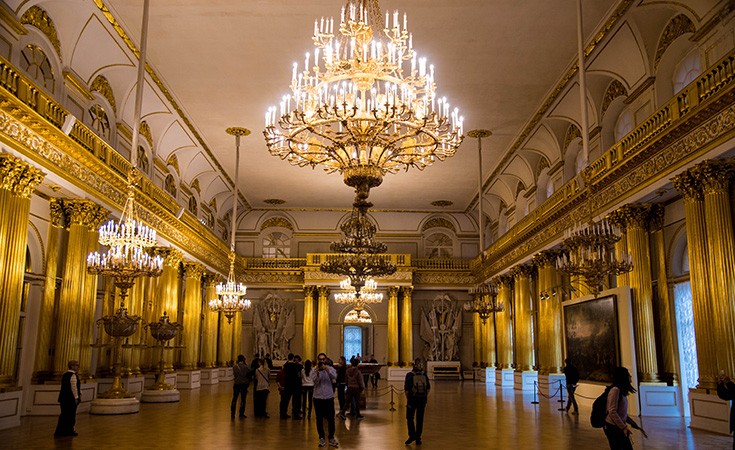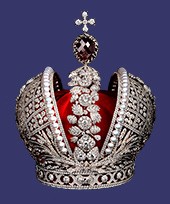
What is Hermitage? How are we supposed to introduce it to our visitors? We can get started like this. In the area of 234,000 m2 totalling to four high-rises, as many as three million works of art are on display with 1,013,653 paintings, 1,125,623 numismatics, 784,395 archeological artefacts, 13,982 weapons and armour and 212,775 other works of art among which are the sculputures of the world famous sculptors.
In 1754, Russian empress Elisabeth Petrovna approved the project of Italian architect Bartolomeo Francesco Rastelli, regarding the construction of the new royal residence for the tsar and his family. The building was constructed in Baroque style. Since the Empress wanted to outshine all other European royal palaces, the construction of the Winter Palace required a hefty amount of money and over 4000 Russian engineers and specialists who were actively working on creating and decorating this picture perfect palace.
The creation of museum Hermitage dates way back to the year 1764, when Catherine the Great purchased an impressive collection of art works from a Berlin merchant Ernest Gotzkowsky. Already in 1769 there was a new collection brought to Sain Petersburg – the Bruhl’s collection. This collection included works of art of some of the most famous Dutch, French, Flaminian and Italian painters of the time.The collection was named after Count Von Bruhl, who was very successful in gathering important paintings from Western Europe. Three years later the most significant and most valuable collection from the eighteenth century arrived in Saint Petersburg – the Crozat’s collection. This collection was purchased from an influential banking family Crozat which contained the paintings of Rubens, Rembrandt and Giorgino. When in 1779 the grandson of British Prime Minister, George Walpole decided to sell his rich collection that was kept in his family castle in Norfolk for years, to Catherine II, Hermitage officially became the richest museum in the world. Hermitage was enriched with paintings of Rembrandt, Rubens, van Dyck, and italian painters from the 17th Century. Hermitage also holds a series of remarkable masterpieces by Leonardo, Raffaelo, Caravaggio and Boticelli.
Hermitage of course is not only dedicated to paintings. Here are also exhibited arts of work from ancient cultures such as an old Slavic culture, antique art, old Egyptian art, as well as the masterpieces of Russian culture and art, Oriental art etc.
Hermitage might be one of the biggest museums in the world but it is surely at the forefront when it comes to its riveting architectural beauty. Royal chambers are dotted with decorations of divine beauty that reflect the richness of the former Russian empire. It is believed that visitors usually come twice to visit Hermitage, the first time to see the art collection and the second time to plunge into lavishly ornamented rooms where Russian emperors used to lived (1057 rooms are located in the Winter Palace only). A typical example of such beauty is so-called „the Throne Hall" (allso called the Hall of St. George), constructed by the famous architect Giacomo Quarenghi. Hopefully our visitors can imagine a neoclassic salon of 800m2 with spacious windows and numerous magenta marble columns. Decorations on the ceiling were made by a French artist Gabriel Doyen and Italian painter Giovanni Pittoni. At the very end of the hall there is the magnificent throne made for the Empress Catherine II.
Golden and Diamond collections of the museum
 It is important to note that by buying a basic ticket, our visitors can visit all four buildings that belong to the Hermitage Museum. However, if our visitors really want to see unique pieces of art and hear stories about Russian emperors and have a sneak peak in their private collections, we suggest that they should visit the Golden and Diamond Collection of the museum. Visitors are not allowed to enter these rooms without a guide. Guides speak multiple languages so most of visitors can listen to the guides in their native language. Visitors will have the opportunity not only to see gold objects from cultures that they had no opportunity to meet before, but also to see the glory of the former great Russian empire.
It is important to note that by buying a basic ticket, our visitors can visit all four buildings that belong to the Hermitage Museum. However, if our visitors really want to see unique pieces of art and hear stories about Russian emperors and have a sneak peak in their private collections, we suggest that they should visit the Golden and Diamond Collection of the museum. Visitors are not allowed to enter these rooms without a guide. Guides speak multiple languages so most of visitors can listen to the guides in their native language. Visitors will have the opportunity not only to see gold objects from cultures that they had no opportunity to meet before, but also to see the glory of the former great Russian empire.
Interesting facts
The museum celebrates its anniversary on December 7th, and this is also the day of St. Catherine.
The ticket price for the entrance to the museum Hermitage in Saint Petersburg
 The ticket price for the entry to the Main Museum Complex and the branches (the Main Museum Complex, the General Staff Building, Winter Palace of Peter the Great, Menshikov Palace, the Museum of the Imperial Porcelain Factory) is 700 RUB.
The ticket price for the entry to the Main Museum Complex and the branches (the Main Museum Complex, the General Staff Building, Winter Palace of Peter the Great, Menshikov Palace, the Museum of the Imperial Porcelain Factory) is 700 RUB.
The ticket price for only one of the Hermitage branches (Winter Palace of Peter the Great, Menshikov Palace, the Museum of the Imperial Porcelain Factory, Staraya Derevnya Restoration and Storage Centre) is 300 RUB.
The first Thursday of each month is a day of free entrance to the museum for all individual visitors (with free tickets).
Free entrance is reserved for preschool children, school children and students.
To visit the Golden and Diamond collection - the ticket price is 350 RUB (per person for each collection). Please bear in mind that these are the exclusive collections of this museum and that you are bound to thoroughly enjoy a unique experience if you decide to visit.
Working hours of Hermitage museum
 Every day from 10:30 am to 6:00 pm.
Every day from 10:30 am to 6:00 pm.
Wednesdays from 10:30am to 9:00 pm.
Museum is closed every Monday, on 1st January and on 9th May.